William Blake

(1757-1827)

Who Was William Blake?
William Blake began writing at an early age and claimed to have had his first vision, of a tree full of angels, at age 10. He studied engraving and grew to love Gothic art, which he incorporated into his own unique works. A misunderstood poet, artist and visionary throughout much of his life, Blake found admirers late in life and has been vastly influential since his death in 1827.
Early Years
William Blake was born on November 28, 1757, in the Soho district of London, England. He only briefly attended school, being chiefly educated at home by his mother. The Bible had an early, profound influence on Blake, and it would remain a lifetime source of inspiration, coloring his life and works with intense spirituality.
At an early age, Blake began experiencing visions, and his friend and journalist Henry Crabb Robinson wrote that Blake saw God's head appear in a window when Blake was 4 years old. He also allegedly saw the prophet Ezekiel under a tree and had a vision of "a tree filled with angels." Blake's visions would have a lasting effect on the art and writings that he produced.
The Young Artist
Blake's artistic ability became evident in his youth, and by age 10, he was enrolled at Henry Pars' drawing school, where he sketched the human figure by copying from plaster casts of ancient statues. At age 14, he apprenticed with an engraver. Blake's master was the engraver to the London Society of Antiquaries, and Blake was sent to Westminster Abbey to make drawings of tombs and monuments, where his lifelong love of gothic art was seeded.
The Maturing Artist
In 1779, at age 21, Blake completed his seven-year apprenticeship and became a journeyman copy engraver, working on projects for book and print publishers. Also preparing himself for a career as a painter, that same year, he was admitted to the Royal Academy of Art's Schools of Design, where he began exhibiting his own works in 1780. Blake's artistic energies branched out at this point, and he privately published his Poetical Sketches (1783), a collection of poems that he had written over the previous 14 years.
In August 1782, Blake married Catherine Sophia Boucher, who was illiterate. Blake taught her how to read, write, draw and color (his designs and prints). He also helped her to experience visions, as he did. Catherine believed explicitly in her husband's visions and his genius, and supported him in everything he did, right up to his death 45 years later.
One of the most traumatic events of Blake's life occurred in 1787, when his beloved brother, Robert, died from tuberculosis at age 24. At the moment of Robert's death, Blake allegedly saw his spirit ascend through the ceiling, joyously; the moment, which entered into Blake's psyche, greatly influenced his later poetry. The following year, Robert appeared to Blake in a vision and presented him with a new method of printing his works, which Blake called "illuminated printing." Once incorporated, this method allowed Blake to control every aspect of the production of his art.
While Blake was an established engraver, soon he began receiving commissions to paint watercolors, and he painted scenes from the works of Milton, Dante , Shakespeare and the Bible.
The Move to Felpham and Charges of Sedition
In 1800, Blake accepted an invitation from poet William Hayley to move to the little seaside village of Felpham and work as his protégé. While the relationship between Hayley and Blake began to sour, Blake ran into trouble of a different stripe: In August 1803, Blake found a soldier, John Schofield, on the property and demanded that he leave. After Schofield refused and an argument ensued, Blake removed him by force. Schofield accused Blake of assault and, worse, of sedition, claiming that he had damned the king.
The punishments for sedition in England at the time (during the Napoleonic Wars) were severe. Blake anguished, uncertain of his fate. Hayley hired a lawyer on Blake's behalf, and he was acquitted in January 1804, by which time Blake and Catherine had moved back to London.
Later Years
In 1804, Blake began to write and illustrate Jerusalem (1804-20), his most ambitious work to date. He also began showing more work at exhibitions (including Chaucer's Canterbury Pilgrims and Satan Calling Up His Legions ), but these works were met with silence, and the one published review was absurdly negative; the reviewer called the exhibit a display of "nonsense, unintelligibleness and egregious vanity," and referred to Blake as "an unfortunate lunatic."
Blake was devastated by the review and lack of attention to his works, and, subsequently, he withdrew more and more from any attempt at success. From 1809 to 1818, he engraved few plates (there is no record of Blake producing any commercial engravings from 1806 to 1813). He also sank deeper into poverty, obscurity and paranoia.
In 1819, however, Blake began sketching a series of "visionary heads," claiming that the historical and imaginary figures that he depicted actually appeared and sat for him. By 1825, Blake had sketched more than 100 of them, including those of Solomon and Merlin the magician and those included in "The Man Who Built the Pyramids" and "Harold Killed at the Battle of Hastings"; along with the most famous visionary head, that included in Blake's "The Ghost of a Flea."
Remaining artistically busy, between 1823 and 1825, Blake engraved 21 designs for an illustrated Book of Job (from the Bible) and Dante's Inferno . In 1824, he began a series of 102 watercolor illustrations of Dante — a project that would be cut short by Blake's death in 1827.
Death and Legacy
In the final years of his life, Blake suffered from recurring bouts of an undiagnosed disease that he called "that sickness to which there is no name." He died on August 12, 1827, leaving unfinished watercolor illustrations to Bunyan's Pilgrim's Progress and an illuminated manuscript of the Bible's Book of Genesis. In death, as in life, Blake received short shrift from observers, and obituaries tended to underscore his personal idiosyncrasies at the expense of his artistic accomplishments. The Literary Chronicle , for example, described him as "one of those ingenious persons ... whose eccentricities were still more remarkable than their professional abilities."
Unappreciated in life, Blake has since become a giant in literary and artistic circles, and his visionary approach to art and writing has not only spawned countless, spellbound speculations about Blake, they have inspired a vast array of artists and writers.
QUICK FACTS
- Name: William Blake
- Birth Year: 1757
- Birth date: November 28, 1757
- Birth City: London, England
- Birth Country: United Kingdom
- Gender: Male
- Best Known For: William Blake was a 19th-century writer and artist who is regarded as a seminal figure of the Romantic Age. His writings have influenced countless writers and artists through the ages.
- Fiction and Poetry
- Christianity
- Astrological Sign: Sagittarius
- Royal Academy of Art's Schools of Design
- Death Year: 1827
- Death date: August 12, 1827
- Death City: London, England
- Death Country: United Kingdom
We strive for accuracy and fairness.If you see something that doesn't look right, contact us !
CITATION INFORMATION
- Article Title: William Blake Biography
- Author: Biography.com Editors
- Website Name: The Biography.com website
- Url: https://www.biography.com/authors-writers/william-blake
- Access Date:
- Publisher: A&E; Television Networks
- Last Updated: May 27, 2021
- Original Published Date: April 2, 2014
- I am under the direction of messengers from Heaven daily and nightly.
- The vision of Christ that thou dost see is my vision's greatest enemy. Both read the Bible day and night, but thou readst black where I read white.
Famous British People

The Real Royal Scheme Depicted in ‘Mary & George’

William Shakespeare

Anya Taylor-Joy

Kate Middleton, Princess of Wales

Kensington Palace Shares an Update on Kate

Amy Winehouse

Prince William

Where in the World Is Kate Middleton?

Christopher Nolan

Emily Blunt

Jane Goodall

Who are they?
Who is William Blake?
Meet the artist who saw angels (and ghosts!)...and painted pictures of them!
After William Blake The Man Who Taught Blake Painting in his Dreams (counterproof) (after c.1819–20) Tate
Did you know that the artist William Blake once saw angels in a tree in a London park called Peckham Rye? He used to have lots of visions like that.
William Blake was a poet and a painter who was born in Soho in London in 1757. He is an important figure of the Romantic age. Which was a time when artists and writers reacted to the massive changes happening in Europe, such as new machinery and big factories making cities much bigger and industrial. Romantic artists were excited by emotions and tried to reflect the awe and wonder of the natural world.
Blake was a very religious man and he felt that the amazing things he saw in the world came from God. Here is one of his paintings. It is a scene from the Bible where a dead man comes alive again.
After William Blake The Raising of Lazarus Tate
William Blake didn't really think of himself as a poet and a painter, he thought of himself as a craftsman. He thought all painters should be craftsmen and not think of themselves as better than that.
As well as painting Blake also made books of his poems which he illustrated. One of his most famous works is a book called Songs of Innocence and Experience . It was published in 1789 and was inspired by illuminated manuscripts made by monks in medieval times. One of the most famous poems in the book is called The Tyger .
William Blake Songs of Innocence and Experience
William Blake Songs of Experience, The Tyger Copy F, plate 42 © Yale Center for British Art, Paul Mellon Collection
The painting below is called The Good and Evil Angels .
Can you guess which is the good angel and which is the evil angel?
William Blake The Good and Evil Angels (1795–?c.1805) Tate
The evil angel has a chain attached to its ankle. Some art experts think this symbolises rational thought.
Rational thought is what we call it when there is a scientific explanation for something. The 1700s is often called the Age of Enlightenment, because it was a time when science began to explain many things about the world. Blake was worried that science would explain everything and then people might stop believing in God.
William Blake Elohim Creating Adam (1795–c.1805) Tate
William Blake died in 1827. He and his work might have been entirely forgotten because he was so different from every other artist at that time. But the Pre-Raphaelite artists, who came to prominence in the mid–1800s, loved Blake's work and called him a true visionary. Since then he has become an important figure in British art.
He is loved for his poems and his paintings and for the fact that he pursued his own path and was not influenced by others.
William Blake Oberon, Titania and Puck with Fairies Dancing (c.1786) Tate
More to explore

Monsters, Kids and Cornelia Parker

Meet an Illustrator
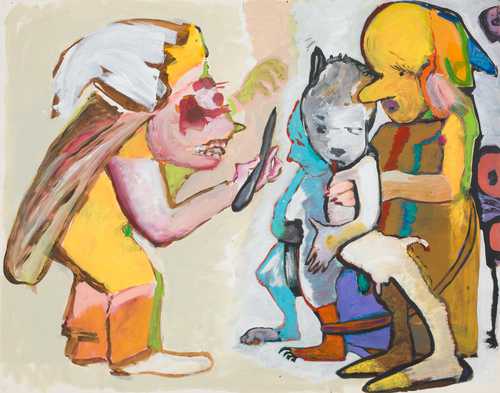
Quiz: Which Art Monster Are You?

Biography Online

Biography William Blake
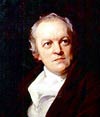
“Tyger, Tyger, burning bright In the forests of the night, What immortal hand or eye Could frame thy fearful symmetry?”
– William Blake – The Tyger (from Songs of Experience )
Short Bio of William Blake
William Blake was born in London 28 November 1757, where he spent most of his life. His father was a successful London hosier and attracted by the Religious teachings of Emmanuel Swedenborg. Blake was first educated at home, chiefly by his mother. Blake remained very close to his mother and wrote a lot of poetry about her. Poems such as Cradle Song illustrate Blake’s fond memories for his upbringing by his mother:
Sweet dreams, form a shade O’er my lovely infant’s head; Sweet dreams of pleasant streams By happy, silent, moony beams. Sweet sleep, with soft down Weave thy brows an infant crown. Sweep sleep, Angel mild, Hover o’er my happy child.
– William Blake
His parents were broadly sympathetic with his artistic temperament and they encouraged him to collect Italian prints. He found work as an engraver, joining the trade at an early age. He found the early apprenticeship rather boring, but the skills he learnt proved useful throughout his artistic life. He became very skilled as an engraver and after completing his apprenticeship in 1779, he set up as an independent artist. He received many commissions and became well known as a skilled artist. Throughout his life, Blake was innovative and his willingness to depict the spirit world in physical form was criticised by elements of the press.
In 1791, Blake fell in love with Catherine Boucher, an illiterate and poor woman from Battersea across the Thames. The marriage proved a real meeting of mind and spirit. Blake taught his wife to read and write, and freely shared his inner and outer experiences. Catherine became a devoted wife and an uncompromising supporter of Blake’s artistic genius.
“Love seeketh not itself to please, Nor for itself hath any care, But for another gives its ease, And builds a heaven in hell’s despair.”
– Songs of Experience, The Clod and the Pebble, st. 1
Mystical experiences and poetry
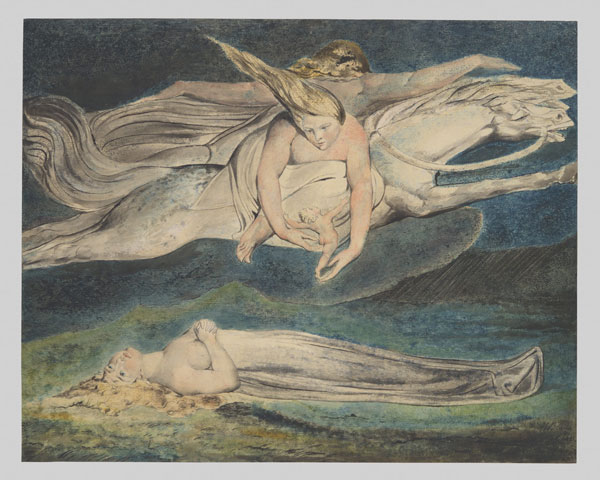
‘Pity’ by William Blake
As a young boy, Blake recalls having a most revealing vision of seeing angels in the trees. These mystical visions returned throughout his life, leaving a profound mark on his poetry and outlook.
“I am not ashamed, afraid, or averse to tell you what Ought to be Told: That I am under the direction of Messengers from Heaven, Daily & Nightly; but the nature of such things is not, as some suppose, without trouble or care.” – Letters of William Blake
William Blake was also particularly sensitive to cruelty. His heart wept at the sight of man’s inhumanity to other men and children. In many ways he was also of radical temperament, rebelling against the prevailing orthodoxy of the day. His anger and frustration at the world can be seen in his collection of poems “ Songs of Experience ”
“How can the bird that is born for joy Sit in a cage and sing? How can a child, when fears annoy, But droop his tender wing, And forget his youthful spring!”
– William Blake: The Schoolboy
As well as writing poetry that revealed and exposed the harsh realities of life, William Blake never lost touch with his heavenly visions. Like a true seer, he could see beyond the ordinary world and glimpse another possibility.
“To see a world in a grain of sand And heaven in a wild flower Hold infinity in the palm of your hand And eternity in an hour.”
This poem from Auguries of Innocence is one of the most loved poems in the English language. Within four short lines, he gives an impression of the infinite in the finite, and the eternal in the transient.
One of Blake’s greatest poems – popularly referred to as ‘Jerusalem’ – was the preface to his epic work “Milton: A poem in two books”. This hymn was inspired by the story that Jesus travelled to Glastonbury, England – in the years before his documented life in the Gospels. To Blake, Jerusalem was a metaphor for creating Heaven on earth and transforming all that is ugly about modern life ‘dark satanic mills’ into ‘England’s green and pleasant land.” Jerusalem, set to music by Hubert Parry in 1916, is often seen as England’s unofficial national anthem.
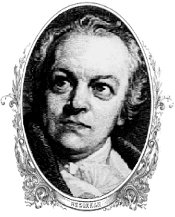
On one occasion he got into trouble with the authorities for forcing a soldier to leave his back garden. It was in the period of the Napoleonic Wars where the government were cracking down on any perceived lack of patriotism. In this climate, he was arrested for sedition and faced the possibility of jail. Blake defended himself and despite the prejudices of those who disliked Blake’s anti-military attitude, he was able to gain an acquittal.
Religion of Blake
Outwardly Blake was a member of the Church of England, where he was christened, married and buried. However, his faith and spiritual experience was much deeper and more unconventional than orthodox religion. He considered himself a sincere Christian but was frequently critical of organised religion.
“And now let me finish with assuring you that, Tho I have been very unhappy, I am so no longer. I am again. Emerged into the light of day; I still & shall to Eternity Embrace Christianity and Adore him who is the Express image of God” – Letters of Blake
For the last few decades of his life, he never attended formal worship but saw religion as an inner experience to be held in private. Throughout his life, he experienced mystical experiences and visions of heavenly angels. These experiences informed his poetry, art and outlook on life. It made Blake see beyond conventional piety and value human goodness and kindness. He was a strong opponent of slavery and supported the idea of equality of man.
“If the doors of perception were cleansed, everything would appear to man as it is: infinite.” – Blake, The Marriage of Heaven and Hell (1790–1793)
Blake read the Bible and admired the New Testament, he was less enamoured of the judgements and restrictions found in the Old Testament. He was also influenced by the teaching of Emanuel Swedenborg, a charismatic preacher who saw the Bible as the literal word of God. Although Blake was, at times, enthusiastic about Swedenborg, he never became a member of his church, preferring to retain his intellectual and spiritual independence.
Blake died on August 12 1827. Eyewitnesses report that his death was a ‘glorious affair’. After falling ill, Blake sang hymns and prepared himself to depart. He was buried in an unmarked grave in a public cemetery and Bunhill Fields. After his death, his influence steadily grew through the Pre-Raphaelites and later noted poets such as T. S. Eliot and W. B. Yeats.
The esteemed poet, William Wordsworth , said on the death of Blake:
“There was no doubt that this poor man was mad, but there is something in the madness of this man which interests me more than the sanity of Lord Byron and Walter Scott.”
The Art of William Blake
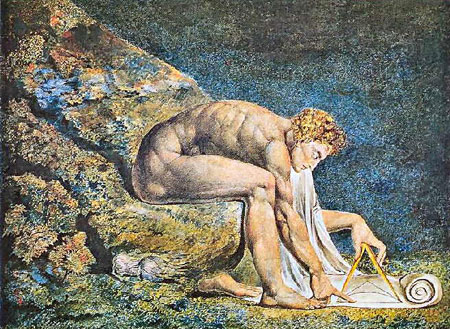
Newton by Blake
Citation: Pettinger, Tejvan . “ Biography of William Blake” , Oxford, UK www.biographyonline.net , 1st June. 2006. Page updated 23rd Jan 2020.
The Complete Poetry & Prose of William Blake

- The Complete Poetry & Prose of William Blake at Amazon.com
- The Complete Poetry & Prose of William Blake at Amazon.co.uk
To See a World in a Grain of Sand

Related pages
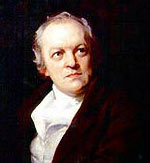
William Blake links
- Quotes of William Blake
- William Blake Biography
- William Blake Poetry
Biography of William Blake, English Poet and Artist
Culture Club / Getty Images
- Favorite Poems & Poets
- Poetic Forms
- Best Sellers
- Classic Literature
- Plays & Drama
- Shakespeare
- Short Stories
- Children's Books
- M.A., Classics, Catholic University of Milan
- M.A., Journalism, New York University.
- B.A., Classics, Catholic University of Milan
William Blake (November 28, 1757–August 12, 1827) was an English poet, engraver, printmaker, and painter. He is mostly known for his lyric poems Songs of Innocence and Songs of Experience, which combine simple language with complex subject matters, and for his epic poems, Milton and Jerusalem, that contrasted the canon of classical epic.
Fast Facts: William Blake
- Known For: Poet and engraver known for his seemingly simple poems containing complex themes and their companion illustrations and prints. As an artist, he is known for devising an innovative technique for colored engravings called illuminated printing.
- Born: November 28, 1757 in Soho, London, England
- Parents: James Blake, Catherine Wright
- Died: August 12, 1827 in London, England
- Education: Largely homeschooled, apprenticed with engraver James Basire
- Selected Works: Songs of Innocence and of Experience (1789), The Marriage of Heaven and Hell (1790-93), Jerusalem (1804–1820), Milton (1804-1810)
- Spouse: Catherine Boucher
- Notable Quote: “To see a World in a Grain of Sand And a Heaven in a Wild Flower, Hold Infinity in the palm of your hand And Eternity in an hour.” And "It is easier to forgive an enemy than to forgive a friend."
William Blake was born on November 28, 1757. His parents were Henry and Catherine Wright Blake. His family worked in the hosiery business and as small tradesmen, and money was tight but they weren’t poor. Ideologically, his parents were dissenters who challenged the teachings of the church, but they used the Bible and religious passages to interpret events of the world around them. Blake was raised with a sense that the righteous would triumph over the privileged.
Growing up, Blake was considered "different" and he was homeschooled. At age 8 or 10, he reported seeing angels and spangled stars, but it was a world where having visions wasn’t so peculiar. His parents recognized his artistic talent and his father bought him plaster casts and gave him small change to buy prints at auction houses. That’s where he was first exposed to the works of Michelangelo and Raffaello. From age 10 to 14, he went to drawing school, and after that, he started his apprenticeship with an engraver, where he stayed for the next seven years.
The engreaver's name was James Basire and he was the official engraver of the Society of Antiquaries and of the Royal Society. He never had more than two apprentices. Near the end of his apprenticeship, Blake was sent to Westminster Abbey to draw the tombs of the ancient kings and queens of England. This “gothicized” Blake’s imaginary, as he acquired a feeling of the medieval, which proved to be lasting influence throughout his career.
The Engraver (1760-1789)
Blake finished his apprenticeship at age 21 and became a professional engraver. For some time, he was enrolled in the Royal Academy of Arts in London. Four years later, in 1782, he married Catherine Boucher, an illiterate woman who is said to have signed her marriage contract with an X. Blake soon taught her to read, write, and etch.
In 1783, he published Poetical Sketches, and opened his own print shop with fellow apprentice James Parker in 1784. It was a turbulent time in history: the American revolution was coming to a close, and the French revolution was approaching. It was a period marked by instability, which affected him enormously.
Innocence and Experience (1790-1799)
Tyger Tyger, burning bright, In the forests of the night; What immortal hand or eye, Could frame thy fearful symmetry?
In what distant deeps or skies. Burnt the fire of thine eyes? On what wings dare he aspire? What the hand, dare seize the fire?
And what shoulder, & what art, Could twist the sinews of thy heart? And when thy heart began to beat, What dread hand? & what dread feet?
What the hammer? what the chain, In what furnace was thy brain? What the anvil? what dread grasp, Dare its deadly terrors clasp!
When the stars threw down their spears And water'd heaven with their tears: Did he smile his work to see? Did he who made the Lamb make thee?
Tyger Tyger burning bright, In the forests of the night: What immortal hand or eye, Dare frame thy fearful symmetry?
In 1790, Blake and his wife moved to North Lambeth and he had a decade of success, where he made enough money to produce his best known works. These include Songs of Innocence (1789) and Songs of Experience (1794) which are the two states of the soul. These were first written separately and then published together in 1795. Songs of Innocence is a collection of lyric poems, and superficially they appear to be written for children. Their form, however, sets them apart: they’re hand printed and hand colored works of art. The poems do have a nursery-rhyme quality about them.
Songs of Experience presents the same themes as Songs of Innocence, but examined from the opposite perspective. “The Tyger” is one of the most notable examples; it’s a poem that's seen in dialogue with “The Lamb of Innocence” where the speaker asks the lamb about the Creator who made it. The second stanza answers the question. “The Tyger” consists of a series of questions that are not answered, and is a source of energy and fire, something uncontrollable. God made both “The Tyger” and “The Lamb” and by stating this, Blake defied the idea of moral opposites.
Marriage of Heaven and Hell (1790–1793), a prose work containing paradoxical aphorisms, presents the devil as a heroic figure; while Visions of the Daughters of Albion (1793) combines radicalism with ecstatic religious imagery. For these works, Blake invented the style of "illuminated printing," in which he reduced the need of two different workshops that were till then needed to make an illustrated book. He was in charge of every single stage of production, and he also had freedom and could avoid censorship. In this period he produced Jerusalem and what is known as “Minor Prophecies.”
Later Life (1800-1827)
And did those feet in ancient time Walk upon Englands mountains green: And was the holy Lamb of God, On Englands pleasant pastures seen!
And did the Countenance Divine, Shine forth upon our clouded hills? And was Jerusalem builded here, Among these dark Satanic Mills?
Bring me my Bow of burning gold: Bring me my arrows of desire: Bring me my Spear: O clouds unfold! Bring me my Chariot of fire!
I will not cease from Mental Fight, Nor shall my sword sleep in my hand: Till we have built Jerusalem, In Englands green & pleasant Land.
Blake's success did not last forever. By 1800, his lucrative period was over and he took a job in Felpham, Sussex, to illustrate the works of William Hailey. While in Sussex, he had a fight with a drunk soldier who accused him of speaking treasonable words against the king. He went to trial and was acquitted.
After Sussex, Blake returned to London and started working on Milton (1804–1808) and Jerusalem (1804–20), his two epic poems, the latter of which has its premise in a poem contained in the preface of the former. In Milton, Blake turned away from the classical epics—while typically this format deals with war, Milton was about poetic inspiration, featuring Milton coming back to Earth trying to explain what had gone wrong. He wants to set mankind against the movement towards war, which he identifies in the celebration of the classics, and wants to rectify with a celebration of christianity.
In Jerusalem, Blake portrayed the “sleep of Albion,” a figure for the nation, and it encouraged people to think beyond their limits. Jerusalem is a utopian idea on how mankind can live. Around 1818, he wrote the poem “The Universal Gospel.” In parallel to his poetic activity, his illustration business thrived. His Bible illustrations were popular objects, and in 1826, he was commissioned to illustrate Dante’s Divine Comedy . While this work was cut short by his death, the existing illustrations show that they’re not just decorative pieces, but are actually a commentary on the source material.
William Blake died on August 12, 1827, and was buried in a ground for dissenters. On the day of his death, he still worked on his Dante illustrations.
Themes and Literary Style
Blake's style is easy to recognize, both in poetry and in his visual art. There’s something askew that makes him stand out among late-18th-century poets. His language is straightforward and unaffected, yet powerful in its directness. His work contains Blake’s own private mythology, where he rejects moral absolutes that mark the authoritarianism of organized religion. It draws from the Bible as well as Greek and Norse mythology. In The Marriage of Heaven and Hell (1790–1793) for example, the Devil is actually a hero rebelling against the authoritarianism of an impostor, a worldview that is mitigated in his later works; in Milton and Jerusalem, for instance, self-sacrifice and forgiveness are portrayed as redeeming qualities.
Not a fan of organized religion, Blake only went to Church three times in his life: when he was christened, when he married, and when he died. He espoused the ideas of enlightenment, but he placed himself in a critical position towards it. He talked about Newton , Bacon, and Locke as the “Satanic Trinity” who had restricted it, leaving no place for art.
Blake was a fierce critic of colonialism and enslavement, and was critical of the church because he claimed the clergy used their power to keep people down with the promise of the afterlife. The poem in which he expresses his vision of enslavement is “Visions of the Daughters Albion,” which features an enslaved girl who is raped by her enslaver and is jilted by her lover because she is not virtuous anymore. As a consequence, she launches in a crusade for social, political, and religious freedom, but her story ends in chains. This poem equates rape with colonialism, and also sheds light on the fact that rape was actually a common occurrence in plantations. The Daughters of Albion are the English women who wanted to end enslavement.
There is a complex mythology surrounding Blake, which makes every generation find something in his work that appeals to their specific time. In our time, one of the greatest threats is sovereignty, which manifests itself in Brexit and the presidency of Donald Trump, and Blake notably spoke of similar regimes as “great evil.”
William Blake remained neglected for one generation after his death, until Alexander Gilchrist wrote his Life of William Blake in 1863, which led to a newfound appreciation for Blake among the pre-Raphaelites, such as Dante Gabriel Rossetti (who illustrated the Divine Comedy, too) and Algernon Swinburne. Yet, he labelled him a pictor ignotus, which means “unknown painter,” which hinted at the obscurity he had died in.
The modernists deserve credit for fully bringing Blake into the canon. W.B. Yeats resonated with Blake’s philosophical ideas, and also edited an edition of his collected works. Huxley cites Blake in his work The Doors of Perception, while beat poet Allen Ginsberg , as well as songwriters Bob Dylan, Jim Morrison, and Van Morrison all found inspiration in Blake’s work.
- Blake, William, and Geoffrey Keynes. The Complete Writings of William Blake; with Variant Readings . Oxford U.P., 1966.
- Bloom, Harold. William Blake . Blooms Literary Criticism, 2008.
- Eaves, Morris. The Cambridge Companion to William Blake . Cambridge University Press, 2007.
- “The Forum, The Life and Works of William Blake.” BBC World Service , BBC, 26 June 2018, www.bbc.co.uk/programmes/w3cswps4.
- A Guide to William Blake's 'The Tyger'
- 14 Classic Poems Everyone Should Know
- Patriotic Poems for Independence Day
- A Classic Collection of Bird Poems
- Understanding the Definition of an Acrostic Poem
- Profile of William Butler Yeats
- 7 Classic Poems for Fathers
- Possessive Pronoun - Definition and Examples
- William Wordsworth
- A Collection of Classic Love Poetry for Your Sweetheart
- Yeats and 'The Symbolism of Poetry'
- Life of Bonny Lee Bakley, Murdered Wife of Actor Robert Blake
- Biography of Anne Brontë, English Novelist
- Biography of Walt Whitman, American Poet
- What Is Prose?
- Biography of Hilda Doolittle, Poet, Translator, and Memoirist
Heilbrunn Timeline of Art History Essays
William blake (1757–1827).
Songs of Experience: The Tyger
William Blake
The Angel Appearing to Zacharias
The Parable of the Wise and Foolish Virgins
Angel of the Revelation (Book of Revelation, chapter 10)
Elizabeth E. Barker Department of Drawings and Prints, The Metropolitan Museum of Art
October 2004
William Blake (1757–1827), one of the greatest poets in the English language, also ranks among the most original visual artists of the Romantic era . Born in London in 1757 into a working-class family with strong nonconformist religious beliefs, Blake first studied art as a boy, at the drawing academy of Henry Pars. He served a five-year apprenticeship with the commercial engraver James Basire before entering the Royal Academy Schools as an engraver at the age of twenty-two. This conventional training was tempered by private study of medieval and Renaissance art; as revealed by his early designs for Edward Young’s Night Thoughts ( Nature revolves, but Man advances ), Blake sought to emulate the example of artists such as Raphael, Michelangelo, and Dürer in producing timeless, “Gothic” art, infused with Christian spirituality and created with poetic genius.
In 1782, Blake married Catherine Boucher (1762–1831), an impoverished grocer’s daughter who would become his studio assistant. Blake now threw his energies into developing his career as an engraver, opening a short-lived print shop with a fellow Basire apprentice (James Parker) in 1784, before striking out on his own ( Job, a Historical Engraving ). The great advance in Blake’s printmaking occurred in 1787, following the untimely death, probably from tuberculosis, of the artist’s beloved younger brother Robert, who had been living with William and Catherine since 1784. Blake reported discovering his wholly original method of “relief etching”—which creates a single, raised printing surface for both text and image—in a vision of Robert soon after his death. Relief etching allowed Blake to control all aspects of a book’s production: he composed the verses, designed the illustrations (preparing word and image almost simultaneously on the same copper printing plate), printed the plates, colored each sheet by hand (where necessary), and bound the pages together in covers. The resulting “illuminated books” were written in a range of forms—prophecies, emblems, pastoral verses, biblical satire, and children’s books—and addressed various timely subjects—poverty, child exploitation, racial inequality, tyranny, religious hypocrisy. Not surprisingly, these works rank among Blake’s most celebrated achievements ( 17.10.42 ; The Ancient of Days ; Los, his Spectre; and Enitharmon before a Druid Temple ).
Blake’s technical experiments of the 1790s culminated in a series of large color prints notable for their massive size and iconic designs. Unaccompanied by any text, they comprise his most ambitious work as a visual artist. No commission or public exhibition is recorded, and the intended program of the group remains uncertain: of the twelve known designs, many of the subjects—drawn from the Bible, Shakespeare ( 58.603 ), Milton, and other sources ( Newton )—function as pairs.
Blake described his technique as “fresco.” It appears to be a form of monotype: using oil and tempera paints mixed with chalks, Blake painted the design onto a flat surface (a copperplate or piece of millboard), from which he pulled the prints simply by pressing a sheet of paper against the damp paint. He finished the designs in ink and watercolor , making each—rare—impression unique.
For Blake, the Bible was the greatest work of poetry ever written, and comprised the basis of true art, as opposed to the false, pagan ideal of classicism. He found a sympathetic patron in Thomas Butts (1757–1845), a prosperous Swedenborgian (a member of the Protestant sect founded by the eighteenth-century Swedish scientist, philosopher, theologian, and visionary Emanuel Swedenborg). Butts amassed a small fortune as a clerk in the office of the Muster Master General, and became Blake’s most loyal patron and closest friend. During the decade 1799–1809, Butts commissioned from Blake a series of illustrations to the Bible that included about fifty tempera paintings ( 51.30.1 ) and more than eighty watercolors ( 14.81.2 ). These focus on Old Testament prefigurations of Christ, the life of Christ , and apocalyptic subjects from the Book of Revelation, although the series’ exact program and its intended display remain unclear.
For the rest of his life, Blake continued to develop his art on an inward-looking, imaginative trajectory. Whereas notable contemporaries such as J. M. W. Turner and John Constable found the subjects of their art in the landscape, Blake sought his (primarily figural) subjects in journeys of the mind. (Indeed, he never traveled outside of Britain and, aside from a brief period on the southern coast of England—where he worked for the poet William Hayley in Felpham from 1800 to 1803—spent his entire life in London.) In addition to the Bible and his own writings, Blake drew on other texts—most notably, Dante ( Beatrice addressing Dante from the Car )—and found a seemingly inexhaustible source of inspiration in his own fertile mind ( The Ghost of a Flea ).
Barker, Elizabeth E. . “William Blake (1757–1827).” In Heilbrunn Timeline of Art History . New York: The Metropolitan Museum of Art, 2000–. http://www.metmuseum.org/toah/hd/blke/hd_blke.htm (October 2004)
Further Reading
Bindman, David. William Blake: His Art and Times . Exhibition catalogue. New Haven: Yale Center for British Art, 1982.
Butlin, Martin. William Blake . Exhibition catalogue. London: Tate Gallery, 1978.
Hamlyn, Robin, and Michael Phillips. William Blake . Exhibition catalogue. New York: Harry N. Abrams, 2001.
Additional Essays by Elizabeth E. Barker
- Barker, Elizabeth E.. “ The Printed Image in the West: Mezzotint .” (October 2003)
- Barker, Elizabeth E.. “ Joseph Mallord William Turner (1775–1851) .” (October 2004)
- Barker, Elizabeth E.. “ John Constable (1776–1837) .” (October 2004)
- Barker, Elizabeth E.. “ Watercolor Painting in Britain, 1750–1850 .” (October 2004)
Related Essays
- Albrecht Dürer (1471–1528)
- John Constable (1776–1837)
- Romanticism
- The Salon and the Royal Academy in the Nineteenth Century
- Watercolor Painting in Britain, 1750–1850
- Ernest Hemingway (1899–1961) and Art
- Joseph Mallord William Turner (1775–1851)
- The Printed Image in the West: Engraving
- Shakespeare and Art, 1709–1922
- Shakespeare Portrayed
List of Rulers
- List of Rulers of Europe
- Great Britain and Ireland, 1600–1800 A.D.
- Great Britain and Ireland, 1800–1900 A.D.
- 18th Century A.D.
- 19th Century A.D.
- Architecture
- Biblical Scene
- British Literature / Poetry
- Christianity
- Deity / Religious Figure
- Great Britain and Ireland
- Italian Literature / Poetry
- Literature / Poetry
- New Testament
- Old Testament
- Pastoral Scene
- Printmaking
- Religious Art
Artist or Maker
- Blake, William
- Constable, John
- Dürer, Albrecht
- Turner, Joseph Mallord William
Online Features
- 82nd & Fifth: “Be Prepared” by Constance McPhee
- Connections: “Endings” by Chris Coulson
- Connections: “Poetry” by Jennette Mullaney
- National Poetry Month
- Materials for Teachers
- Literary Seminars
- American Poets Magazine

Main navigation
- Academy of American Poets
User account menu

Search more than 3,000 biographies of contemporary and classic poets.
Page submenu block
- literary seminars
- materials for teachers
- poetry near you
William Blake
William Blake was born in London on November 28, 1757, to James, a hosier, and Catherine Blake. Two of his six siblings died in infancy. From early childhood, Blake spoke of having visions—at four he saw God “put his head to the window”; around age nine, while walking through the countryside, he saw a tree filled with angels. Although his parents tried to discourage him from “lying,” they did observe that he was different from his peers and did not force him to attend a conventional school. Instead, he learned to read and write at home. At age ten, Blake expressed a wish to become a painter; so, his parents sent him to drawing school. Two years later, Blake began writing poetry. When he turned fourteen, he apprenticed with an engraver because art school proved too costly. One of Blake’s assignments as apprentice was to sketch the tombs at Westminster Abbey, exposing him to a variety of Gothic styles from which he would draw inspiration throughout his career. After his seven-year term ended, he studied briefly at the Royal Academy.
In 1782, Blake married an illiterate woman named Catherine Boucher. Blake taught her to read and write, and also instructed her in draftsmanship. Later, she helped him print the illuminated poetry for which he is remembered today; the couple had no children. In 1784, Blake set up a print shop with friend and former fellow apprentice, James Parker; but this venture failed after several years. For the remainder of his life, Blake made a meager living as an engraver and illustrator for books and magazines. In addition to his wife, Blake also began training his younger brother, Robert, in drawing, painting, and engraving. Robert fell ill during the winter of 1787, having probably succumbed to consumption. As Robert died, Blake saw his brother’s spirit rise up through the ceiling, “clapping its hands for joy.” He believed that Robert’s spirit continued to visit him and later claimed that in a dream Robert taught him the printing method that he used in Songs of Innocence and other “illuminated” works.
Blake’s first printed work, Poetical Sketches (1783), is a collection of apprentice verse, mostly imitating classical models. The poems protest against war, tyranny, and King George III’s treatment of the American colonies. He published his most popular collection, Songs of Innocence , in 1789 and followed it, in 1794, with Songs of Experience . Some readers interpret Songs of Innocence in a straightforward fashion, considering it primarily a children’s book, but others have found hints at parody or critique in its seemingly naive and simple lyrics. Both books of Songs were printed in an illustrated format reminiscent of illuminated manuscripts. The text and illustrations were printed from copper plates, and each picture was finished by hand in watercolors.
Blake was a nonconformist who associated with some of the leading radical thinkers of his day, including Thomas Paine and Mary Wollstonecraft. In defiance of eighteenth-century Neoclassical conventions, he privileged imagination over reason in the creation of both his poetry and images, asserting that ideal forms should be constructed not from observations of nature but from inner visions. He declared in one poem, “I must create a system or be enslaved by another man’s.” Works such as “The French Revolution” (1791), “America, a Prophecy” (1793), “Visions of the Daughters of Albion” (1793), and “Europe, a Prophecy” (1794) express his opposition to the English monarchy, and to eighteenth-century political and social tyranny in general. Theological tyranny is the subject of The Book of Urizen (1794). In the prose work The Marriage of Heaven and Hell (1790–93), he satirized the oppressive authority of both church and state, as well as the works of Emanuel Swedenborg, a Swedish philosopher whose ideas once attracted his interest.
In 1800, Blake moved to the seacoast town of Felpham, where he lived and worked until 1803 under the patronage of William Hayley. He taught himself Greek, Latin, Hebrew, and Italian, so that he could read classical works in their original language. In Felpham, Blake experienced profound spiritual insights that prepared him for his mature work, the great visionary epics written and etched between about 1804 and 1820. Milton (1804–08); Vala, or The Four Zoas (1797; rewritten after 1800); and Jerusalem (1804–20) have neither traditional plot, characters, rhyme, nor meter. They envision a new and higher kind of innocence—the human spirit triumphing over reason.
Blake believed that his poetry could be read and understood by common people, but he was determined not to sacrifice his vision in order to become popular. In 1808, he exhibited some of his watercolors at the Royal Academy and, in May 1809, he exhibited his works at his brother James’s house. Some of those who saw the exhibit praised Blake’s artistry, but others thought the paintings “hideous” and more than a few called him insane. Blake’s poetry was not well known by the general public, but he was mentioned in A Biographical Dictionary of the Living Authors of Great Britain and Ireland , published in 1816. Samuel Taylor Coleridge , who had been lent a copy of Songs of Innocence and of Experience , considered Blake a “man of Genius,” and William Wordsworth made his own copies of several songs. Charles Lamb sent a copy of “The Chimney Sweeper” from Songs of Innocence to James Montgomery for his Chimney-Sweeper’s Friend, and Climbing Boys’ Album (1824), and Robert Southey (who, like Wordsworth, considered Blake insane) attended Blake’s exhibition and included the “Mad Song” from Poetical Sketches in his miscellany, The Doctor (1834–37).
Blake’s final years, spent in great poverty, were cheered by the admiring friendship of a group of younger artists who called themselves “the Ancients.” In 1818, he met John Linnell, a young artist who helped him financially and also helped to create new interest in his work. It was Linnell who, in 1825, commissioned him to design illustrations for Dante ’s Divine Comedy , the cycle of drawings that Blake worked on until his death in 1827.
Related Poets
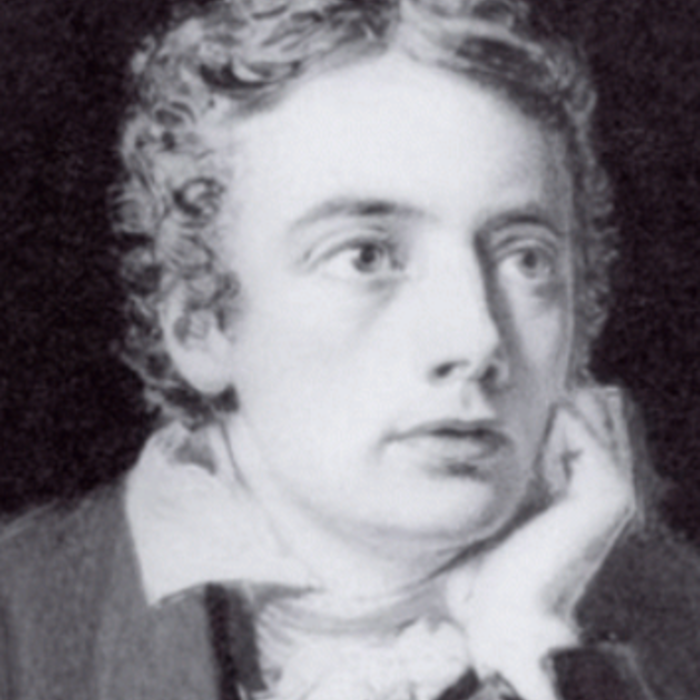
William Wordsworth
William Wordsworth, who rallied for "common speech" within poems and argued against the poetic biases of the period, wrote some of the most influential poetry in Western literature, including his most famous work, The Prelude , which is often considered to be the crowning achievement of English romanticism.
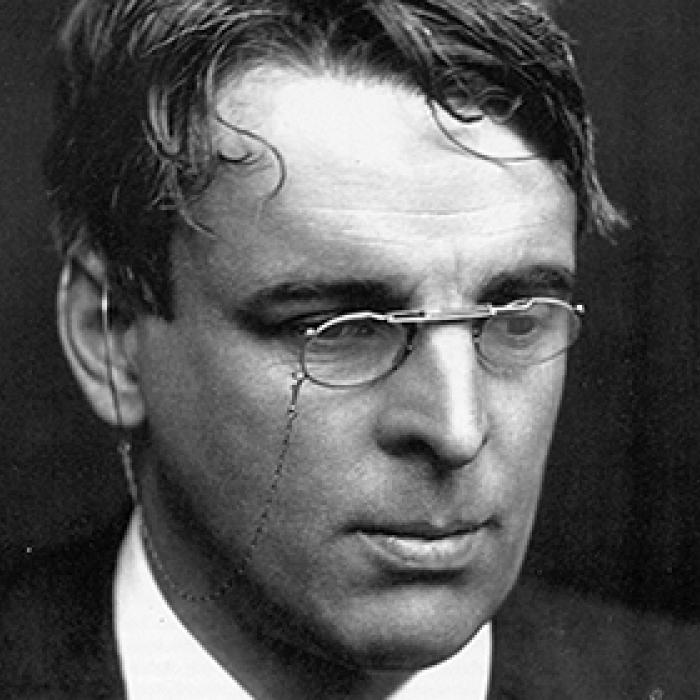
W. B. Yeats
William Butler Yeats, widely considered one of the greatest poets of the English language, received the 1923 Nobel Prize for Literature. His work was greatly influenced by the heritage and politics of Ireland.
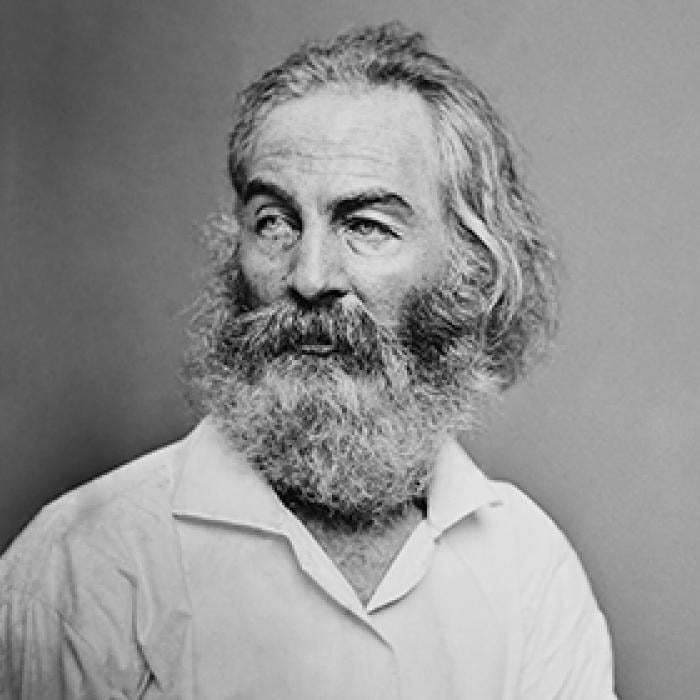
Walt Whitman
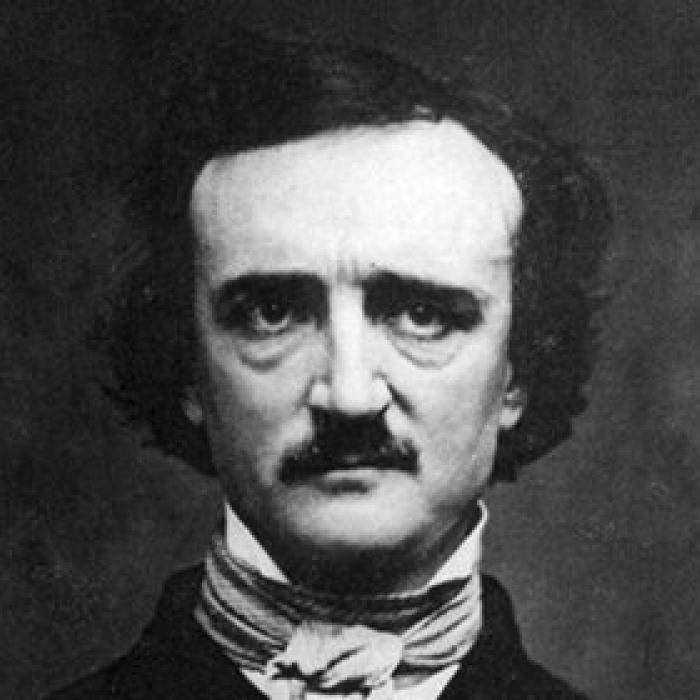
Edgar Allan Poe
Born in 1809, Edgar Allan Poe had a profound impact on American and international literature as an editor, poet, and critic.
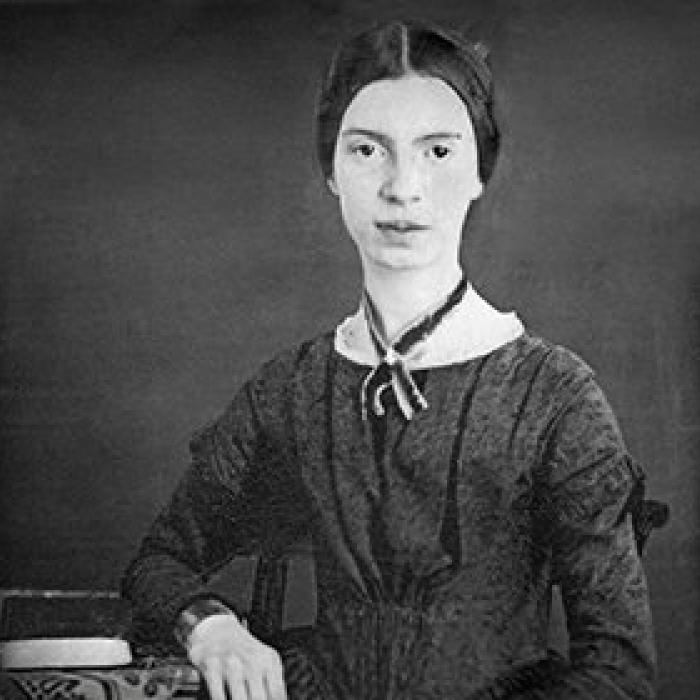
Emily Dickinson
Emily Dickinson was born on December 10, 1830, in Amherst, Massachusetts. While she was extremely prolific as a poet and regularly enclosed poems in letters to friends, she was not publicly recognized during her lifetime. She died in Amherst in 1886, and the first volume of her work was published posthumously in 1890.
Newsletter Sign Up
- Academy of American Poets Newsletter
- Academy of American Poets Educator Newsletter
- Teach This Poem
(92) 336 3216666
William Blake
William Blake was a painter, poet, and print-maker. During his lifetime, he was not recognized much. However, now, he is regarded as an influential figure in the history of visual arts and poetry in the Romantic period. His works were highly prophetic. Northrop Frye, the twentieth-century critic, says that the works of William Blake are least studied in the English language.
The 21 st -century artist, Jonathan Jones, comments on his visual arts that his art is remote from whatever Britain has produced so far. Among the 100 Greatest Britons, BBC has placed William Blake on number 38 in 2002.
William Blake lived in London for his entire life; there, he produced versatile and symbolically rich works. His works employed the imagination of the “human existence itself,” and the body of God.”
For his idiosyncratic views, the contemporary writers and poets consider him as mad. However, the later critics regarded him for his creativity and expressiveness, as well as for his mystical and philosophical undercurrents within his works. His poetry and painting are featured as Pre-Romantics and past of the Romantic Movement.
William Blake was a committed Christian, yet aggressive to the Church of England. Even he was against all forms of hostile religions. He was greatly influenced by the American and French Revolution in the 18 th century. William Blake also abandoned political beliefs but maintained friendly relations with the political activists Thomas Paine. Thinkers such as Emanuel Swedenborg also influenced him greatly.
Though Blake had many known influences, the uniqueness and distinguishing quality of his works makes him difficult to categorize. He has been categorized as “glorious luminary” and a man who had not been envisioned by the predecessors and was not ranked with his contemporaries by William Michael, the 19 th -century critic.
A Short Biography of William Blake
William Blake was born on 28 th November 1757 in London. He attended school for a short period of time and then got further education at home. In the early years, Blake was highly influenced by the Bible. It remained a lifetime source of inspiration and colored his life and works with spirituality.
Blake started experiencing visions at an early age. When Blake was four years old, writes Henry Crabb, he saw the head of God appearing in the window. He also supposedly envisions the prophet Ezekiel standing under the tree and also had seen a tree filled with angels. It was these visions that affect his writing and paintings he produced.
By the age of 10, the artistic abilities of William Blake came to the forefront. He attended Henry Pars’ drawing school. There he learned to sketch the human figure. He also apprenticed with engravers at the age of 14. The master of Blake was an engraver to the London Society of Antiques. He sent Blake to Westminster Abbey to draw the monuments and tombs. In that place, his love for gothic was established.
In 1779, Blake finished his apprenticeship that comprised seven years. He turned into a journeyman copy engraver. He started working on projects for print and book publishers. During that time, he was also preparing himself to make his career as a painter. In the same year, he attended the Royal Academy of Art’s School of Design. In 1780, he started exhibiting his own works in the Academy. In 1783, he published his Poetical Sketches . It was a collection of poems that he wrote over the course of 14 years.
In 1782, William Blake married an illiterate lady Catherine Sophia Boucher. She was taught to read, write, and color. She was a great supporter of her husband until his death.
In 1787, William Blake suffered greatly from the death of his brother Robert. At the instance of his brother’s death, Blake envisions a spirit coming down joylessly through the ceiling. This vision entered into the mind of Blake and greatly inspired his later poetry.
In the following years, Blake started a new method of printing called “illuminating printing.” This painting influenced every aspect of his arts.
An established engraver, William Black, soon started receiving commissions for his watercolors. He painted the scenes from the Bible and works of Shakespeare, Dante, and Milton.
In 1800, William Blake shifted to a seaside Village of Felpham upon the invitation of his friend William Hayley. However, soon the relationship between Blake and Hayley soon turned bitter. Blake ran into different trouble. A soldier, in 1803, illegally occupied the property of Blake, and when Blake asked him to leave, he accused him of sedation and assault.
In 1804, Black was acquitted, and he, along with his wife, shifted back to London. In the same year, Blake started writing and illustrating about Jerusalem. His works on Jerusalem are his most aspiring works to date. He also started showing his works, including the Canterbury Pilgrims by Chaucer and Satan Calling Up His Legions, at the exhibitions. However, his works did not get any appreciation.
Devastated by the negative reviews and no attention for his works, Blake started withdrawing from his attempt of success. From 1809 to 1818, he only sketched a few paintings. He was sinking into paranoia, obscurity, and poverty.
However, in 1819, Blake started sketching “visionary head.” Until 1825, Blake had sketched more than 100 of such visionary heads.
Between 1823 and 1825, Blake remained highly busy with his arts. He engraved almost 21 designs of Book of Job and Dante’s Inferno. By 1825, he also started a series of watercolor illustrations of Dante.
In the last years of his life, William Blake suffered from an undiagnosed disease. He died on 12 th August 1827. He left unfinished watercolor illustrations of Pilgrim’s Progress by Bunyan and manuscript of the Book of Genesis of the Bible.
Though he was unappreciated in his life, William Blake turned out to be a great figure in the arts of poetry and paintings.
William Blake’s Writing Style
William blake as a romantic poet.
William Blake belongs to the period of Romantic poets. In his works, the features of Romanticism are marked vividly. Like romantics, his poetry is largely based on subjectivity, imagination, expression, freedom of thought, and the idealization of nature.
Though the Romantic Movement officially started in the nineteenth with the publication of Lyrical Ballads in 1830, William Blake shows blows of classicism in his poetry at the end of the 17 th century. According to William Black, any piece of art is an embodiment of the vision and imagination of the poet.
Many writers of the 17 th century, including William Blake, were greatly influenced by the French Revolution and war between France and England. William Black was against the ancient ideals that were practiced in his time. He composed his poem “There is no Natural Religion” and “All Religions are One” in hopes to bring change to the spiritual life of the public. Unlike most people, Blake had a feeling that his spiritual life is dramatic, free, and not consistent,
The poetry and writing style of William Blake resembles the spirit of Romanticism. Imagination, mysticism, idealization of childhood, humanitarian sympathies, love of liberty, and symbolism are the major features of his poetry. He attributes great importance to these features in his poetry. His poetry is set in the pastoral setting and has lyrical qualities. For example,
“Bring me my bow of burning gold!
Bring me my arrows of desire!
Bring me my spear! O clouds, unfold!
Bring me my Chariot of fire!” (Jerusalem, lines 9 to 12)
Distinguishing Feature of Blake’s Poetry
The above lines from the poem show the lyrical qualities of Blake’s poetry. Blake does not employ the traditional verse form of poetry in his poems. He scorned the poetry and criticism that is based on classicism. He asserts that if we are truly in our imagination, we do not want Roman or Greek models for criticism. He disgusted the whole diction employed by the neoclassical poets. He could not tolerate it. His poetry contains simple diction and words used by ordinary people.
Blake as a Visionary Poet
Blake’s poetry and paintings are both controlled by his visions , and his visions are solely based on his own imagination. In his many poems, he claimed that these visions were dictated to him by spirits. He says that a poet writes poetry with the help of inspiration, and in this state of inspiration, the poet uses his imagination.
He also claims that the imagination of humans is the divine vision and realization. Moreover, the expression of divine vision is accompanied by energy and delight. The intense romantic nature of Blake made him have such views of the poetry. Imagination is the key element in the poetry of Blake. For example, in the poem “Tyger,” Blake creates the image of falling spares of stars and watering of heavens with the tears of stars. Moreover, he asks that does God smiles when he see his creation and also inquires that the one who made lamb also made you (tiger)
The poem symbolically represents the impassioned defense of imagination and energy. These things occupy a great place in the thinking of Blake. In the poem, the tiger symbolizes the “abundant life” and regeneration. The terrifying though splendid qualities of the tiger are effectively conveyed in the poem.
The poetry of William Blake is not only filled with the Revolutionary spirit. In his poetry, he also deals with the subject of the child with intense seriousness. For example, in his poem, “Holy Thursday I,” he writes:
“O what a multitude they seemd these flowers of London town
Seated in companies they sit with radiance all their own
The hum of multitudes was there but multitudes of lambs
Thousands of little boys & girls raising their innocent hands”
The child in this poem symbolizes the courageous yet delicate instinct in the human mind. Whatever the child observed is filled with beauty and mystery. The words are simple and possible as it suits the thoughts of the child.
Romantic Elements in Blake’s Poetry
In the writing style of William Blake, romantic elements are present in abundance. Some of these elements are present to a high degree. For example, in his poems, there is a sense of wonder, an intimate sympathy with the diversity of existence, and observation of nature. Whereas, other elements are present to a lesser degree. For example, nostalgia and escapism.
The early style of William Blake was the immature form of Romanticism. His poem “The Songs of Innocence” is adapted with the definition of Romanticism that “it is the renaissance of wonder.” In the poem “Tyger,” the splendid qualities of the tiger creates a sense of amazement and wonder. He writes about the physical feature of the tiger that the tiger is so strong that the shoulder or art can twist the strength of its heart. He also asks what makes his heart beat, whose dread hands and dread feets are making the strongest creature dradfull.
Humanitarian Approach of Blake
William Blake had strong sympathies with humanity and supported liberty. He was a great admirer of the French Revolution and the American Revolution. For example, the humanitarian sympathies of Blake have seen the poems such as The Chimney Sweeper, London, and Holy Thursday. He writes that he wonders about each poor creature on the street near the river Thames. In every face he meets, there are marks of woe and weakness. Moreover, he writes that in the cry of every man, in the fearful cry of infants, in the voice voice these poor creatures utter, he hears the mind-forged manacle.
The poetry of William Blake also deals with rapid industrialization and its effects on human life. It deals with how human lives and child labor are exploited at the hands of industrialization. For example, in the poem “The Chimney Sweeper,” William Blake talks about the poor child and the labor he is put into and speaks in the voice of a child that he was very young when his mother died and his father sold him even though he could only cry. So he was put in the job of cleaning a chimney and he would sleep in soot. Moreover, when another poor baby cried because his head was shaved, he calmed him down by saying that while sleeping in the soot, his hair won’t get dirty because his head is shaved.
Blake also criticizes the various forms of social injustices taking place in London. He shows these injustices in the form of Chimney Sweeper, the youthful Harlot’s curse, and the sign of a helpless soldier. He asserts that though people are not chained with chains, they are made slaves mentally. He seems to be the enemy of the artificial handcuffs that are created by the mind.
Anti-Clerical Views of Blake
Moreover, Blake also does not show mercy to the Church. In his poetry, the Church is an inhospitable place; whereas the ale-house is friendly and warm. The Church imposes religious restrictions. Blake is against all organized institutions of religion.
Pastoralism in Blake’s Poetry
Another striking feature is the writing style of Blake is Pastoralism. His poem “The Shepard” is a simple poem that celebrates the happiness of truth and responsibility in a rural atmosphere. Similarly, his poem “The Echoing Green” also deals with the delightful domesticity and warmer hue with expressive melody.
William Blake is one of the major poets of the 18 th century whose poetry and artwork became a part of the movement of Romanticism. His writing is a combination of a variety of styles. He is a lyric poet, a mystic, a visionary, and an artist. His works both in poetry and arts fascinate charms and sometimes puzzle the readers. Blake intensely used metaphors, images, symbols, and revolutionary spirit in his poetry. These things combine with a spontaneous expression of emotions and thoughts, and simple diction makes his poetry pleasing and charming.
Works Of William Blake
- The Chimney Sweeper
Local Histories
Tim's History of British Towns, Cities and So Much More
A Brief Biography of William Blake
By Tim Lambert
His Early Life
William Blake was a famous poet, painter, and engraver of the late 18th century and early 19th century. Blake was a radical, anti-authority figure.
William Blake was born at 28 Broad Street in Soho, London on 28 November 1757. His father James Blake was a hosier. He and his wife Catherine had 6 children. Apart from William, they had 4 boys and 1 girl.
From an early age, William Blake was artistic. He also had ‘visions’ of things like angels. When he was 14 William was made apprentice to an engraver called James Basire. William served 7 years and became an engraver himself in 1779. Blake also wanted to paint and the same year he became a student at the Royal Academy of Arts.

On 18 August 1782, William Blake married Catherine Sophia Boucher at the Church of St Mary in Battersea. Blake also wrote poems. A book of poems called Poetical Sketches was published in 1783. In 1789 he published a book of poems called The Song of Innocence.
In 1793 Blake published Visions of the Daughters of Albion. The same year, in 1793 Blake published The Marriage of Heaven and Hell. Also in 1793, Blake published America, a Prophecy.
The Great Poet
In 1794 Blake published a book of poems called Songs of Experience. It included the famous poem The Tiger. The Book of Urizen was also published in 1794. Also in 1794, William Blake published Europe, a Prophecy.
In 1800 William Blake moved to the village of Felpham near Bognor in Sussex. Then on 12 August 1803, Blake got into a fight with a soldier named John Schofield who entered his garden. Schofield later told a magistrate that Blake damned the king of England during the altercation. William Blake was tried for sedition (a serious charge) in Chichester in January 1804. However, he was acquitted.
Meanwhile in 1803 Blake and his wife returned to London. In the years 1804-1810, William Blake wrote and illustrated his work Milton A Poem in Two Books. The preface included the famous poem now known as Jerusalem, which was written in 1804. (Blake did not give it that title. It was originally called ‘And did those feet in ancient time’. Hubert Parry wrote music for it in 1916). In 1820 Blake painted The Goblin. He also painted a miniature called The Ghost of a Flea.
In 1825 Blake was commissioned to illustrate Divine Comedy by Dante but he died before he could complete the task. William Blake died on 12 August 1827. He was buried in Bunhill Fields in London.
Share this:
- Click to share on Twitter (Opens in new window)
- Click to share on Facebook (Opens in new window)
- Click to share on LinkedIn (Opens in new window)
- Click to share on WhatsApp (Opens in new window)
William Blake, His Life and Works Essay (Biography)
William Blake is one of the well-known literary figures in England who is still in the memory of most people because of his excellent skills in painting, visionary mystic, engraving, and poetry. He was born on 28 November 1757 to an underprivileged household living in London and this condition of his family made him to receive little education and privileges when he was in his early years.
Blake was largely unrecognized during his lifetime, may be because he dropped out of school in order to work in his father’s shop. However, he is now regarded as one of the influential figures in the history of both poetry and visual arts of the Romantic Age since his works talk about the supremacy of the imagination over the rationalism and materialism of that period.
Blake started to embrace biblical teachings early in life, and these remained his source of motivation even in his later life (Blunt; Bronowski). In his early life, he also began engraving copies of drawings of Greek antiquities given to him by his father, and these drawings gave him an early exposure to a number of classical works by various authors.
Because of his love for drawing, he was enrolled in drawing classes and he also made explorations into the world of poetry during that period. At fourteen years of age, he was apprenticed for a period of seven years to the British engraver, James Basire. After the completion of this term, he became a professional engraver. On October, 1779, he was enrolled at The Royal Academy for a six-year period. While at the school, he maintained the classical precision of his previous influences.
Blake was married to Catherine Boucher on 18 August, 1782, whom he taught how to read and write as well as engrave. Catherine thereafter assisted her husband in coloring his poems and giving him beneficial suggestions. In one of his books, The Book of Thel, Blake writes about the pain he had after the demise of his first daughter and last child.
Apart from the few years he spent in school, Blake was self-educated and most of his pictorial work mainly represented biblical subjects. Blake’s elaborate paintings and engravings were therefore mainly associated to literature. The interdependence of poetry and painting formed the key principle in all his work and represented his idiosyncratic views. Even though he spent most of his lifetime around the city of London, he authored a wide variety of literary works, which embraced the human imagination as “the very body of God.”
Blake was seen as mad because of the peculiar views he held. On the other hand, his expressiveness and creativity has currently made him an influential figure in the poetry world. The philosophical and mystical undercurrents that are demonstrated within his work were characterized to be part of the Romantic Movement and “Pre-Romantic,” because of their huge appearance during the late eighteenth century and early nineteenth century.
During this period, his country was ruled by the oppressive British Monarchy and the corrupt Church of England; therefore, this atmosphere of oppression was suffocating to the talented, intelligent Blake. These happenings made him to voice out his views in the disguise of romantic poems.
The principles and aspirations of the French as well as of the American revolutions largely influenced his life and such theorists like Jacob Bohme and Emanuel Swendenborg also played a pivotal role in shaping his ideals. In spite of these known influences, the singularity of his work complicates any efforts to classify his work, for example, William Rossetti classified him as a “glorious luminary,” while Peter Marshall classified him as one of the forerunners of modern anarchism.
The development of Blake’s views can be seen in the differences that are evident between his early and late works. For that reason, Blake’s later literary work includes a private mythology with complicated use of symbols, his late work has received less preference than his earlier easily available work, for instance, the recent Vintage anthology of Blake was based on his earlier work.
His earlier work has been seen by many scholars as mainly rebellious in character; therefore, it as been regarded as a form of protestation against dogmatic religion, for example, “The Marriage of Heaven and Hell” depicts Satan as the victor who rebels against an imposter authoritarian deity.
In Blake’s later works, for example, “Milton” and “Jerusalem,” he portrays a distinguishing image of mankind as redeemed through self-sacrifice and forgiveness. He, however, maintains his previous position concerning the inflexible and gruesome authoritarianism of traditional belief system. Very few people have been able to understand the association that exists between Blake’s earlier and later works.
Some scholars have suggested that his late works showed a growth of the ideas he had when writing his earlier works, for instance, the humanitarian objective of realizing personal wholeness of body and spirit was displayed in his late works. This is evident in one of his later writings, “The Unholy Bible,” which has a section that depicts the “Bible of Hell” pledged in one of his earlier works.
Even though Blake criticized conservative religion, his denunciation of religiosity did not mean that he was totally against religion. His thoughts regarding orthodoxy Christianity is seen in “The Marriage of Heaven and Hell,” which are series passages that emulate the Biblical prophecy wherein he lists numerous Proverbs of Hell.
In “The Everlasting Gospel,” he gives a well-thought description of Jesus. He describes Him as a supremely created being, which is above code of belief, logic, and even principles. However, he does not present him as philosopher or conventional messianic figure. He sees Jesus as the one who forms the important connection and union that exists between divinity and humanity.
He was respectful to the word of God as given in the Bible but aggressive to the Church of England (Blake, 34). Blake formulated his own mythology that is evident in all his prophetic writings wherein he introduces some characters such as ‘Urizen,’ and ‘Bromion.’ Blake derived his mythology from the Bible and from some Greek scholars. His ideas of the everlasting gospel are mostly based on this mythology.
One of his major criticisms of conventional religion stems from the fact that he felt that it fostered the containment of human natural desires and depressed earthly happiness. This position that he takes is evident in “A vision of the Last Judgment” where he says that men get entrance into heaven, not because they have controlled their passions, but because they have been able to cultivate their inner understandings (Frye).
In “The Marriage of Heaven and Hell,” he says that he does not agree to the orthodox ideology of a distinct body from the soul, and which must be under the submission of the soul. However, he says that the body is an extension of the soul taken from the ‘discernment’ of the human five senses.
Therefore, the importance traditionalism puts on the rejection of earthly joy is a dualistic error. This error is derived from misapprehension of the association that exists between the body and the soul. In another place, he describes Satan as in the ‘State of error’ and as in a condition wherein he cannot come to repentance.
Blake had a complicated connection with Enlightenment philosophy and because of his religious affiliation, he did not agree with the Newtonian view of the universe. This way of thinking is depicted in “Jerusalem” where he also illustrates his opposition to the ‘single-vision’ of scientific materialism.
In spite of his clear disagreement to Enlightenment philosophy, he reached at a linear aesthetic. This position was somewhat the same to the neoclassical engravings of John Flaxman than to the works of the Romantics. Consequently, he has been seen as one of the enlightenment poets and artists. This is because he was in agreement with that movement’s denial of received ideas, regulations, and conventions.
However, Blake was viewed as being in opposition of what he thought as the elevation of reason to the level of a tyrannical regime. In his disapproval of reason, law, and uniformity, he has been seen as contradicting the enlightenment principles. However, a number of scholars have argued that, in a dialectical sense, he employed the enlightenment drive of denunciation to disapprove narrow notions of the enlightenment principles.
In many of his poems and paintings, Blake talked about the concept of universal humanity, abhorrence to slavery, and strong belief in racial and sexual equality. For example, in one of his poems, “The Book of Thel,” he asked about the essence of living here in the world.
This poem is thought to be a composition in honor of his dead newborn child. Until his death on 12 August, 1827, Blake maintained an active interest in the social and political happenings that were taking place during that time (De Selincourt). He presented his statements using mystical symbolism.
His position on what he perceived as intolerable extended to the Christian faith. His religious views are depicted in Songs of Experience. In this book, he differentiates between the Old Testament God, and the New Testament God. The restrictions of the former were rejected while those of the latter were accepted. In response to Blake’s Songs of Experience, D.C. Williams (1899-1983), said that Blake used the literary work to depict the suffering and loss posed by the nature of society and the world of his time.
Throughout history, poets have been influenced to a large extent by the environment that they live in, and William Blake was no exception. His literary works have influential opposing views and comments concerning different social and political events during his time.
In particular, he talked about important issues regarding human nature, the oppressive British monarchy, and the Christian faith. These views were safe from prosecution. This is because he skillfully masked them in symbolic language that could not be understood by many of his adversaries.
Works Cited
Blake, William. The complete poetry and prose of William Blake. Ed. David V. Erdman. New York: Anchor Books, 1982. Print.
Blunt, Anthony. The art of William Blake. New York: Columbia University Press, 1959. Print.
Bronowski, Jacob. William Blake, 1757-1827; a man without a mask. London: Secker & Warburg, 1947. Print.
De Selincourt, Basil. William Blake. New York: Haskell House Publishers, 1971. Print.
Frye, Northrop. Blake; a collection of critical essays. New Jersey: Prentice Hall, 1966. Print.
- Chicago (A-D)
- Chicago (N-B)
IvyPanda. (2022, June 3). William Blake, His Life and Works. https://ivypanda.com/essays/william-blake/
"William Blake, His Life and Works." IvyPanda , 3 June 2022, ivypanda.com/essays/william-blake/.
IvyPanda . (2022) 'William Blake, His Life and Works'. 3 June.
IvyPanda . 2022. "William Blake, His Life and Works." June 3, 2022. https://ivypanda.com/essays/william-blake/.
1. IvyPanda . "William Blake, His Life and Works." June 3, 2022. https://ivypanda.com/essays/william-blake/.
Bibliography
IvyPanda . "William Blake, His Life and Works." June 3, 2022. https://ivypanda.com/essays/william-blake/.
- The Book "The Steel-Engraving Lady and the Gibson Girl"
- “The Tiger” and “The Lamb” Poems by William Blake
- Imagery and Theme in William Blake’s Poems
- William Blake's Poetry Analysis
- "The Lamb" Poem by William Blake
- Miltonic Motifs in William Blake’s and in Samuel Coleridge’s Books
- Aesthetics of "The Tyger" by William Blake
- The Poem "Tyger" by William Blake
- Literary Analysis on Poetry by William Blake
- Romanticism of Blake's and Ghalib's Poems
- Aesthetics Applied to the Theme of Love and Unreciprocated Love
- Ethics as a Theme in Frankenstein by Mary Shelley
- The Ascent of Money
- Niall Ferguson’s ‘The Ascent of Money’
- Mary Shelley's ‘Frankenstein’: Chapter 18 Analysis
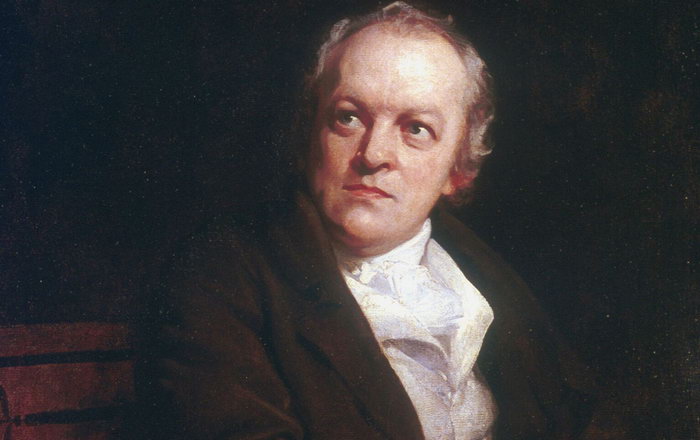
William Blake
William Blake was born in London on November 28, 1757, to James, a hosier, and Catherine Blake. Two of his six siblings died in infancy. From early childhood, Blake spoke of having visions—at four he saw God “put his head to the window”; around age nine, while walking through the countryside, he saw a tree filled with angels. Although his parents tried to discourage him from “lying,” they did observe that he was different from his peers and did not force him to attend conventional school. He learned to read and write at home. At age ten, Blake expressed a wish to become a painter, so his parents sent him to drawing school. Two years later, Blake began writing poetry. When he turned fourteen, he apprenticed with an engraver because art school proved too costly. One of Blake’s assignments as apprentice was to sketch the tombs at Westminster Abbey, exposing him to a variety of Gothic styles from which he would draw inspiration throughout his career. After his seven-year term ended, he studied briefly at the Royal Academy.
In 1782, he married an illiterate woman named Catherine Boucher. Blake taught her to read and to write, and also instructed her in draftsmanship. Later, she helped him print the illuminated poetry for which he is remembered today; the couple had no children. In 1784 he set up a printshop with a friend and former fellow apprentice, James Parker, but this venture failed after several years. For the remainder of his life, Blake made a meager living as an engraver and illustrator for books and magazines. In addition to his wife, Blake also began training his younger brother Robert in drawing, painting, and engraving. Robert fell ill during the winter of 1787 and succumbed, probably to consumption. As Robert died, Blake saw his brother’s spirit rise up through the ceiling, “clapping its hands for joy.” He believed that Robert’s spirit continued to visit him and later claimed that in a dream Robert taught him the printing method that he used in Songs of Innocence and other “illuminated” works.
Blake’s first printed work, Poetical Sketches (1783), is a collection of apprentice verse, mostly imitating classical models. The poems protest against war, tyranny, and King George III’s treatment of the American colonies. He published his most popular collection, Songs of Innocence, in 1789 and followed it, in 1794, with Songs of Experience. Some readers interpret Songs of Innocence in a straightforward fashion, considering it primarily a children’s book, but others have found hints at parody or critique in its seemingly naive and simple lyrics. Both books of Songs were printed in an illustrated format reminiscent of illuminated manuscripts. The text and illustrations were printed from copper plates, and each picture was finished by hand in watercolors.
Blake was a nonconformist who associated with some of the leading radical thinkers of his day, such as Thomas Paine and Mary Wollstonecraft. In defiance of 18th-century neoclassical conventions, he privileged imagination over reason in the creation of both his poetry and images, asserting that ideal forms should be constructed not from observations of nature but from inner visions. He declared in one poem, “I must create a system or be enslaved by another man’s.” Works such as “The French Revolution” (1791), “America, a Prophecy” (1793), “Visions of the Daughters of Albion” (1793), and “Europe, a Prophecy” (1794) express his opposition to the English monarchy, and to 18th-century political and social tyranny in general. Theological tyranny is the subject of The Book of Urizen (1794). In the prose work The Marriage of Heaven and Hell (1790-93), he satirized oppressive authority in church and state, as well as the works of Emanuel Swedenborg, a Swedish philosopher whose ideas once attracted his interest.
In 1800 Blake moved to the seacoast town of Felpham, where he lived and worked until 1803 under the patronage of William Hayley. He taught himself Greek, Latin, Hebrew, and Italian, so that he could read classical works in their original language. In Felpham he experienced profound spiritual insights that prepared him for his mature work, the great visionary epics written and etched between about 1804 and 1820. Milton (1804-08), Vala, or The Four Zoas (1797; rewritten after 1800), and Jerusalem (1804-20) have neither traditional plot, characters, rhyme, nor meter. They envision a new and higher kind of innocence, the human spirit triumphant over reason.
Blake believed that his poetry could be read and understood by common people, but he was determined not to sacrifice his vision in order to become popular. In 1808 he exhibited some of his watercolors at the Royal Academy, and in May of 1809 he exhibited his works at his brother James’s house. Some of those who saw the exhibit praised Blake’s artistry, but others thought the paintings “hideous” and more than a few called him insane. Blake’s poetry was not well known by the general public, but he was mentioned in A Biographical Dictionary of the Living Authors of Great Britain and Ireland, published in 1816. Samuel Taylor Coleridge, who had been lent a copy of Songs of Innocence and of Experience, considered Blake a “man of Genius,” and Wordsworth made his own copies of several songs. Charles Lamb sent a copy of “The Chimney Sweeper” from Songs of Innocence to James Montgomery for his Chimney-Sweeper’s Friend, and Climbing Boys’ Album (1824), and Robert Southey (who, like Wordsworth, considered Blake insane) attended Blake’s exhibition and included the “Mad Song” from Poetical Sketches in his miscellany, The Doctor (1834-1837).
Blake’s final years, spent in great poverty, were cheered by the admiring friendship of a group of younger artists who called themselves “the Ancients.” In 1818 he met John Linnell, a young artist who helped him financially and also helped to create new interest in his work. It was Linnell who, in 1825, commissioned him to design illustrations for Dante‘s Divine Comedy, the cycle of drawings that Blake worked on until his death in 1827.
Poems by William Blake
- Holy Thursday: ‘Twas on a Holy Thursday, their innocent faces clean
- Introduction
- London (Experience)
- The Chimney Sweeper : When my mother died I was very young
- The Nurse’s Song

William Blake
About william blake.
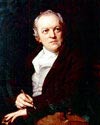
William Blake short poems
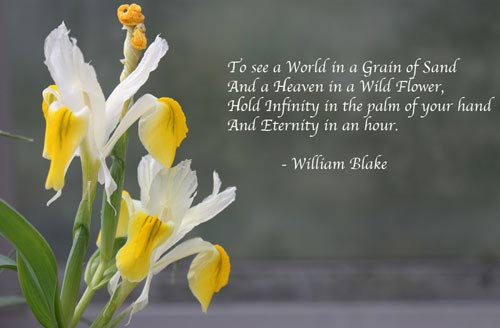
To see a World in a Grain of Sand And a Heaven in a Wild Flower, Hold Infinity in the palm of your hand And Eternity in an hour.
– William Blake (extract from Auguries of Innocence)
Tyger! Tyger! burning bright In the forests of the night, What immortal hand or eye Could frame thy fearful symmetry?
– William Blake (extract from Tyger Songs of Experience)
“I have no name: I am but two days old.” What shall I call thee? “I happy am, Joy is my name.” Sweet joy befall thee! Pretty joy! Sweet joy but two days old, Sweet joy I call thee: Thou dost smile, I sing the while, Sweet joy befall thee!
– William Blake
The Divine Image
To Mercy, Pity, Peace, and Love All pray in their distress; And to these virtues of delight Return their thankfulness. For Mercy, Pity, Peace, and Love Is God, our father dear, And Mercy, Pity, Peace, and Love Is Man, his child and care. For Mercy has a human heart, Pity a human face, And Love, the human form divine, And Peace, the human dress. Then every man, of every clime, That prays in his distress, Prays to the human form divine, Love, Mercy, Pity, Peace. And all must love the human form, In heathen, turk, or jew; Where Mercy, Love, & Pity dwell There God is dwelling too.
The Little Lamb
Little Lamb, who made thee? Dost thou know who made thee? Gave thee life, & bid thee feed By the stream & o’er the mead; Gave thee clothing of delight, Softest clothing, wooly, bright; Gave thee such a tender voice, Making all the vales rejoice? Little Lamb, who made thee? Dost thou know who made thee? Little Lamb, I’ll tell thee, Little Lamb, I’ll tell thee, He is called by thy name, For he calls himself a Lamb. He is meek, & he is mild; He became a little child. I a child, & thou a lamb, We are called by his name. Little Lamb, God bless thee! Little Lamb, God bless thee!
The Little Boy Found
The little boy lost in the lonely fen, Led by the wand’ring light, Began to cry; but God, ever nigh, Appear’d like his father in white. He kissed the child & by the hand led And to his mother brought, Who in sorrow pale, thro’ the lonely dale, Her little boy weeping sought.
The Shepherd
How sweet is the Shepherd’s sweet lot! From the morn to the evening he strays; He shall follow his sheep all the day, And his tongue shall be filled with praise. For he hears the lamb’s innocent call, And he hears the ewe’s tender reply; He is watchful while they are in peace, For they know when their Shepherd is nigh.
A DIVINE IMAGE
Cruelty has a human heart, And Jealousy a human face; Terror the human form divine, And Secrecy the human dress. The human dress is forged iron, The human form a fiery forge, The human face a furnace sealed, The human heart its hungry gorge.
My Pretty Rose Tree
A flower was offered to me, Such a flower as May never bore; But I said, ‘I’ve a pretty rose tree,’ And I passed the sweet flower o’er. Then I went to my pretty rose tree, To tend her by day and by night; But my rose turned away with jealousy, And her thorns were my only delight.
Poison Tree
I was angry with my friend: I told my wrath, my wrath did end. I was angry with my foe: I told it not, my wrath did grow. And I watered it in fears Night and morning with my tears, And I sunned it with smiles And with soft deceitful wiles. And it grew both day and night, Till it bore an apple bright, And my foe beheld it shine, And he knew that it was mine, – And into my garden stole When the night had veiled the pole; In the morning, glad, I see My foe outstretched beneath the tree.
Infant Sorrow
My mother groaned, my father wept: Into the dangerous world I leapt, Helpless, naked, piping loud, Like a fiend hid in a cloud. Struggling in my father’s hands, Striving against my swaddling bands, Bound and weary, I thought best To sulk upon my mother’s breast.
- William Blake at Poetseers

- Stories from the Belle Epoque
- Georgian & Victoian novels
- Elizabethan
- Classic Poetry
- Endymion - Blogging by Moonlight
- Non-fiction
- Other Pages
Tudor / Georgian / Victorian Gothic
- Poetry Readings
Thumbnail sketch of a mystical, revolutionary poet
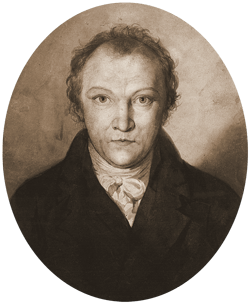
Two Poems by William Blake

- Tudor & Elizabethan novels
- About the Author
- Explore Other Pages
William Blake

Now considered one of the visionary figures of the Romantic Age , William Blake (1757 - 1827) was relatively unknown during his lifetime. He excelled in the visual and literary arts where he practiced as a poet and print maker and engraver. Apparently he set the standard for being the most politically active poet, both in England and America, the likes of which weren't seen again until the emergence of Ezra Pound , over 150 years later.
It would be wrong to say that he worked in obscurity, he was well know to contemporary artists, art critics and those that followed the arts. While he was an excellent engraver, his seven year apprenticeship to James Basire was in a style of line-engraving that was considered dated and old-fashioned. This probably made it difficult for him to not only find work but also to gain a following as public interest was more interested in new styles and techniques.
Like other artistic visionaries, Blake broke free of the boundaries of his time, making it difficult for him to be understood by his contemporaries. Because he was not easily classified and often held what others considered to be somewhat incongruent ideas, some of his contemporaries even considered him mad.
The portrait of William Blake was painted in 1807 by Thomas Phillips.


Vol. 51 no. 2: Fall 2017
William Blake as a Student of the Royal Academy: A Prosopographical Perspective William Blake as a Student of the Royal Academy: A Prosopographical Perspective -->
- Martin Myrone
The day of William Blake’s formal registration as a student at the Royal Academy of Arts in London, 8 October 1779, has often been taken as marking an important turning point in his biography. The date certainly marked an important juncture, following the end of his apprenticeship as an engraver with James Basire (which, if it followed the normal seven-year term, would have been in August 1779) and taking him into the heart of the art establishment, with its program of elevated art practice centered on the ideality of the classical body and the moral and political commitment of the high-minded artist. Even if Blake’s relationship with the academy has too often been taken as simply oppositional, an idea that endures despite excellent work that has shown to the contrary that he had a more complex relationship with the art establishment and its values and owed quite specific debts to academic idealism in the formation and direction of his art (however unconventional in many respects), the significance of this date has never really been in doubt. As David Bindman wrote in his seminal study of Blake as a visual artist, “It is difficult to penetrate the obscurity of Blake’s apprentice days, but with his entry into the Royal Academy in 1779 he emerges more clearly; he now became acquainted with more readily identifiable figures and we begin to discern something like a Blake circle.” The date generally provides a neat chapter division in chronological accounts of his life, and a section or section break in exhibition presentations. The biographical dictionary of Blake’s fellow students that this essay accompanies and glosses is intended to offer the materials for a further illumination of this turning point in Blake’s career, if only in rather indirect or circumstantial ways. It offers a perspective on our understanding of Blake as an academy student by providing a volume of data about his peers at the schools, a collective biography (prosopography) that should deepen our sense of Blake’s social and artistic environment and provide one kind of historical measure against which his personal fortunes and achievements might be tested.
Login Register
Forgot your password?

IMAGES
VIDEO
COMMENTS
William Blake was an English engraver, artist, poet, and visionary, author of exquisite lyrics in Songs of Innocence (1789) and Songs of Experience (1794) and profound and difficult "prophecies," such as Visions of the Daughters of Albion (1793), The First Book of Urizen (1794), Milton
Blake was born on November 28, 1757, in London, England. His father ran a hosiery shop. William, the third of five children, went to school only long enough to learn to read and write, and then he worked in the shop until he was 14. When he saw the boy's talent for drawing, Blake's father apprenticed him to an engraver. Photos.com ...
William Blake was a 19th-century writer and artist who is regarded as a seminal figure of the Romantic Age. His writings have influenced countless writers and artists through the ages.
He used to have lots of visions like that. William Blake was a poet and a painter who was born in Soho in London in 1757. He is an important figure of the Romantic age. Which was a time when artists and writers reacted to the massive changes happening in Europe, such as new machinery and big factories making cities much bigger and industrial.
Short Bio of William Blake. William Blake was born in London 28 November 1757, where he spent most of his life. His father was a successful London hosier and attracted by the Religious teachings of Emmanuel Swedenborg. Blake was first educated at home, chiefly by his mother. Blake remained very close to his mother and wrote a lot of poetry ...
Updated on April 22, 2020. William Blake (November 28, 1757-August 12, 1827) was an English poet, engraver, printmaker, and painter. He is mostly known for his lyric poems Songs of Innocence and Songs of Experience, which combine simple language with complex subject matters, and for his epic poems, Milton and Jerusalem, that contrasted the ...
Poet, painter, engraver, and visionary William Blake worked to bring about a change both in the social order and in the minds of men. Though in his lifetime his work was largely neglected or dismissed, he is now considered one of the leading lights of English poetry, and his work has only grown in popularity. In his Life of William Blake (1863) Alexander Gilchrist warned his readers that Blake ...
William Blake (28 November 1757 - 12 August 1827) was an English poet, painter, and printmaker. Largely unrecognised during his life, Blake is now considered a seminal figure in the history of the poetry and visual art of the Romantic Age.What he called his "prophetic works" were said by 20th-century critic Northrop Frye to form "what is in proportion to its merits the least read body of ...
Blake now threw his energies into developing his career as an engraver, opening a short-lived print shop with a fellow Basire apprentice (James Parker) in 1784, before striking out on his own (Job, a Historical Engraving). The great advance in Blake's printmaking occurred in 1787, following the untimely death, probably from tuberculosis, of ...
Blake's first printed work, Poetical Sketches (1783), is a collection of apprentice verse, mostly imitating classical models. The poems protest against war, tyranny, and King George III's treatment of the American colonies. He published his most popular collection, Songs of Innocence, in 1789 and followed it, in 1794, with Songs of Experience.
William Blake is one of the major poets of the 18th century whose poetry and artwork became a part of the movement of Romanticism. His writing is a combination of a variety of styles. He is a lyric poet, a mystic, a visionary, and an artist. His works both in poetry and arts fascinate charms and sometimes puzzle the readers.
William Blake was an 18th-century English poet, artist, and visionary. He is considered a seminal figure in the Romantic movement, with his works exploring themes such as spirituality, nature, and the human condition. William Blake was unrecognized during his lifetime, but since his death, he has become known as one of the greatest artistic and ...
William served 7 years and became an engraver himself in 1779. Blake also wanted to paint and the same year he became a student at the Royal Academy of Arts. On 18 August 1782, William Blake married Catherine Sophia Boucher at the Church of St Mary in Battersea. Blake also wrote poems. A book of poems called Poetical Sketches was published in 1783.
William Blake, His Life and Works Essay (Biography) William Blake is one of the well-known literary figures in England who is still in the memory of most people because of his excellent skills in painting, visionary mystic, engraving, and poetry. He was born on 28 November 1757 to an underprivileged household living in London and this condition ...
William Blake Biography. Blake was born in 1757 in London. Religion was important in his family and became a lasting influence on Blake. He was interested in reading and art, and it is believed ...
One day in 1801, when William Blake was living on the Sussex coast, he went on a long country walk when he got into an argument with a thistle. The artist, poet and musician, who experienced ...
Biography. William Blake was born in London on November 28, 1757, to James, a hosier, and Catherine Blake. Two of his six siblings died in infancy. From early childhood, Blake spoke of having visions—at four he saw God "put his head to the window"; around age nine, while walking through the countryside, he saw a tree filled with angels.
About William Blake William Blake was a poet, painter, visionary mystic, and engraver. During his life the prophetic message of his writings were understood by few and misunderstood by many. However Blake is now widely admired for his soulful originality and lofty imagination. The poetry of William Blake is far reaching in its scope and range […]
William Blake biography - a brief sketch of one of England's great mystical and Romantic poets. ... In 1800 he left London to live and work for a short while in Sussex but returned to the capital in 1803 where he continued to write and to illustrate his own verse with assistance from Catherine who often worked alongside him. His poems remain ...
Pen Name: William Blake. Born: 28 November 1757. Died: 12 August 1827. Now considered one of the visionary figures of the Romantic Age, William Blake (1757 - 1827) was relatively unknown during his lifetime. He excelled in the visual and literary arts where he practiced as a poet and print maker and engraver. Apparently he set the standard for ...
The day of William Blake's formal registration as a student at the Royal Academy of Arts in London, 8 October 1779, has often been taken as marking an important turning point in his biography. The date certainly marked an important juncture, following the end of his apprenticeship as an engraver with James Basire (which, if it followed the normal seven-year term, would have been in August ...